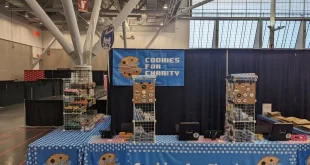Graveyards, Ghosts & Haunted Houses from Rather Dashing Games will delight kids and parents alike as they work to gather the biggest collection of ghosts.
 The object of the game is as simple as the fill-in-the-box line games students often play on graph paper. Instead of drawing lines, however, players each have a hand of tiles from the stack and take turns laying them on the table. As the board grows, players compete to have the largest connecting swath of their ghosts’ color.
The object of the game is as simple as the fill-in-the-box line games students often play on graph paper. Instead of drawing lines, however, players each have a hand of tiles from the stack and take turns laying them on the table. As the board grows, players compete to have the largest connecting swath of their ghosts’ color.
The bulk of strategy in Graveyards, Ghosts & Haunted Houses comes from optimizing from the choices of tiles in a player’s hand. Each time a tile is laid, players will have to re-evaluate their plans. Players may wish to block opponents who are building long chains of ghosts, or they may suddenly have found a new chance to build large sections of their own.
To this solid foundation of icon-matching, several levels of strategy are added by Action Icons, Haunted Houses, and Tokens. Several tiles that may be seen as unwanted since they have mixes of colors come with icons at the center that allow a player to rotate, swap, or even replace another tile across the board. Strategies may be to hold these tiles until late in the game when all the well-laid tiles of an opponent can be interrupted just by rotating one of them, or to swap a tile early on and connect two groups of ghosts into one big one.
 Players can “lock” a series of tiles by placing their Haunted House grid on them, scoring extra points for ghosts of their color in the windows as well as maintaining their field of points from opponents moving tiles. Yet even then the ghosts are susceptible to Tokens such as the Meddling Kids (which gives bonus points), a Paranormal Investigator (which gives negative points), and the Gravestone (which blocks connecting ghosts, potentially cutting a whole collection of points in half). Players will have to study their options, not only the tiles in their hands but when to best use their tokens to maximize their own points or cut an opponent down to size.
Players can “lock” a series of tiles by placing their Haunted House grid on them, scoring extra points for ghosts of their color in the windows as well as maintaining their field of points from opponents moving tiles. Yet even then the ghosts are susceptible to Tokens such as the Meddling Kids (which gives bonus points), a Paranormal Investigator (which gives negative points), and the Gravestone (which blocks connecting ghosts, potentially cutting a whole collection of points in half). Players will have to study their options, not only the tiles in their hands but when to best use their tokens to maximize their own points or cut an opponent down to size.
In addition to its captivating gameplay, the rich theme of Graveyards, Ghosts & Haunted Houses will keep players coming back again and again. Each ghost is cartoony enough not to be outright frightening to young players, yet their facial expressions and props encourage players to ponder what their creepy stories may be. The whimpering gray ghost clutches a bouquet, the stumbling blue ghost with his hobo’s hat may be lost, the orange-yellow kid ghost seems scared of himself, and the mustached green ghost is just a hoot.
Graveyards, Ghosts & Haunted Houses is a tile-laying game for two to four players aged eight and up. Games usually last about half an hour, a solid time-frame for keeping game night moving and reliable as players work their way through the tile deck. With its quick-math, pattern recognition, and need to plan uses for the tokens, this is an ideal game for cognitive development. Not only kids will enjoy the game, however; it is certainly one in which parents and younger players alike will strive to compete in the mixed field of luck and skill.
 Blogcritics The critical lens on today's culture & entertainment
Blogcritics The critical lens on today's culture & entertainment



